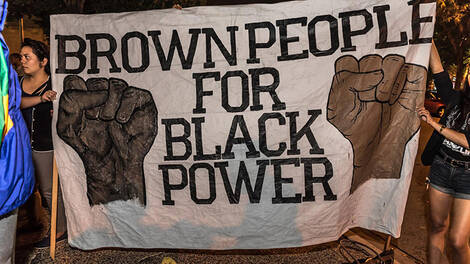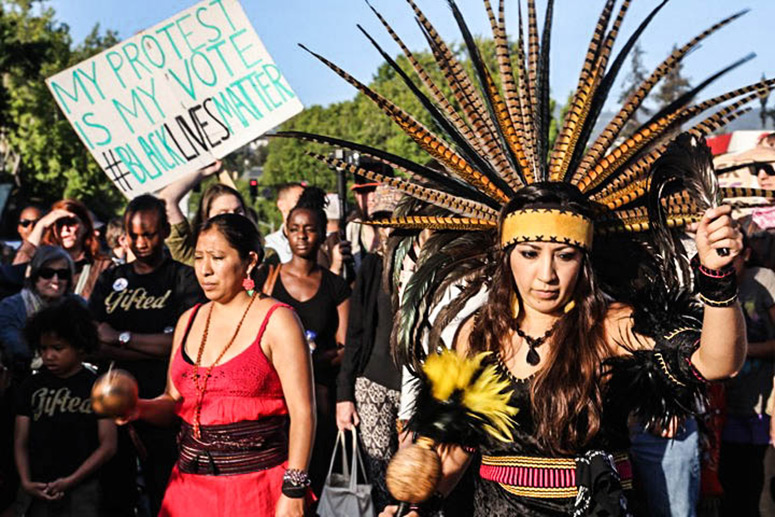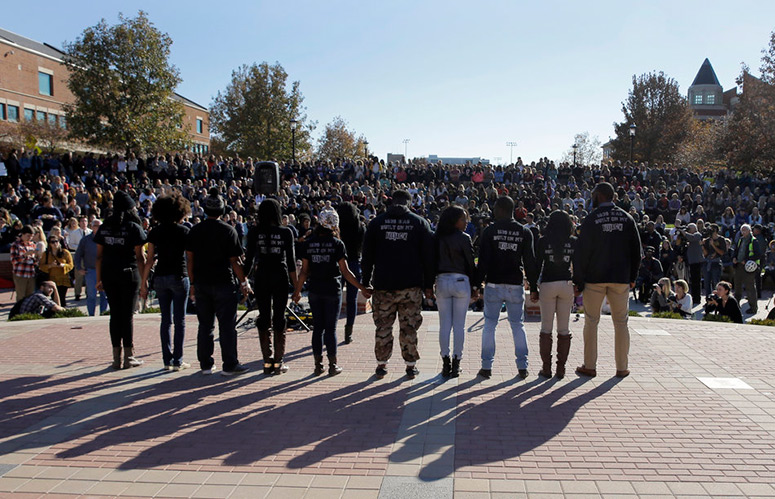
Black and Brown Solidarity

Deep rooted tensions between Latinx and Black communities play a role in contemporary responses to discrimination, yet now that people of color are noticeably speaking up against issues of police brutality, racial profiling, gentrification, immigration, and representation in the country, the union between these communities can only strengthen these efforts. Over the last few years, there has been an overwhelming response by people of color to systemic racism and oppression in the country.
Black and Brown communities fall victim to civil injustices more than any other group in society. Racism is very much alive in America and is not only witnessed by people of color, but also proven in broad reaching studies. African American, Latinx and Indigenous communities have dealt with being treated and viewed as the “sub-humans” of society throughout history due to racist social processes and historical patterns rooted in colonialism.

“If we, as Black and Brown folks, are able to sit down and realize how much overlap we have in our struggles, then we’ll be able to ameliorate [the] places of tension” expresses Urban Affairs scholar, Ofelia Bello, “we have a deep stake in each other’s liberation. It’s really undeniable if we look at all the places where our struggles overlap. Some of the laws that have been put into place to exclude, African Americans in particular, have also excluded Latinos. […] during the Jim Crow era, the same laws were nicknamed “Juan Crow” in some Southwest states as well. [...] How could we not develop alliances and influences with each other if we faced such harsh conditions under the oppression of capitalist white supremacy?”
Currently, race and immigration are at the forefront of the presidential election and candidates are bluntly placing blame and attacking these communities and their needs. The death count from police brutality cases continues to grow despite the uproar of protest from the victims’ families and communities. 945 people were fatally shot by police in 2015. Officials are not being held accountable for their actions and government leaders are not working to make changes to stop this from happening. Being 30+ years past the Civil Rights Movement and having elected an African-American President, it is not a stretch to expect the country to have progressed from its roots of racial injustice. Nevertheless, despite the strides that have been made throughout American history for the expansion and respect of civil rights, people of color continue to not only suffer from the deep rooted racism of this country, but also from divisions between these communities.
According to Ohio State University professor and author, Michelle Alexander, "class anxieties have been highly racialized ever since the Civil War” she explains, “elites have repeatedly exploited racial fears and economic insecurity in order to prevent poor and working people of all colors from imagining that they have common interests." This has led to older generations continuing to have these anxieties and mistrust between different racial groups. In order for a true change to happen, older generations must leave behind the grudges and internalized racism towards each other.
So, despite sharing hardships, deep-rooted tensions between these two minority groups has notably affected the progression for social change. However, Black and Brown unity is not a contemporary concept. “The best example of maintaining an alliance were the Black Panthers and the Brown Berets, ”said Journalism and Chicano Studies student, Daniela Alvarez. “If something similar to those groups and their views was available to young Black and Brown people of today, we could succeed in an alliance.”
Brown and Black solidarity is essential during this time where people of color are the predominant victims of racial and class injustices. There is power in numbers and the truth behind this statement is seen in many ways lately —currently in presidential campaign rallies, as well as in protests to stop racist campaign rallies. When masses of people come together for a common purpose it is not only powerful, but effective. Over the last few years the number of people speaking out against civil rights issues on the streets, and more prominently, in social media, proves that these issues are changing social structures on a grander scale. People are able to connect with and support each other nationwide through social media which also allows their message/cause to branch out to a larger audience.
Thus, society’s current racial climate, African American, Latinx ,and Indigenous millennials are assembling in efforts for social change. Students from universities all over the country have started to speak up and rally against unaddressed institutional racism and oppression that takes place in their campuses. This year, student activists of color at the University of Missouri, more commonly known as Mizzou, took initiative and confronted their System President, Tim Wolfe, about his lack of action and attention towards all the racial complaints issued by the school’s students of color. Students peacefully protested on their campus to voice their concerns about Wolfe’s handling of these complains and demanded to make the institution more inclusive and safe for black students. Black football players began a team boycott and refused to play until there was action taken for the demands of the students. As a result of their efforts, Wolfe resigned. Although his resignation was a form of success, the following day students of color at Mizzou began to receive anonymous death threats, later revealed to have been from white students, through the message posting social media site Yik Yak. This racist backlash is a prime example of the seriousness of this issue and the very present racism in the country. Despite the threats, Mizzou students continue their fight for the basic right of safety on their campus for themselves and for future Mizzou students of color. Their example and efforts led to many other student activist all over the country to show solidarity and do the same at their campuses, including the University of San Francisco.

Mizzou students were part of a recent wave of student led activism through their movement against systemic marginalization of students of color. Their story and cause was so publicized online that it received support from students of all backgrounds across the country.
“Through the use of awareness, solidarity campaigns and peaceful protests, we hope to address the systemic factors at the roots of these issues as well as spread a call to action, because these issues are not black issues — they are American issues” states Yale senior and founder of the Black Ivy Coalition, Reine Ibala, to The Huffington Post.
Both Brown and Black Americans face injustice in this country and this reality is finally making it’s way into what Latino Rebels writer Carlos Martinez says is “mainstream consciousness of America” and they seemingly have something to say about it.
“These reasons basically all fall back on the national (and arguably global) issue of white supremacy. The agenda of white supremacy is to divide and conquer. Black and Latinos are no exception to the workings of this agenda,” mentions Bello. This agenda is the main culprit that gets in the way of solidarity and solidifies tension between disenfranchised communities. Anti-black sentiment continues to be present with older generations of Latinos, while some in the African-Americans continue to perceive Latinos solely as “immigrants." Additionally, according to social and demographic trends research by the Pew Research Center, “nearly half of all blacks say immigrants reduce job opportunities for blacks, while fewer than four-in-10 Hispanics agree.” However the root of this problem tends to be overlooked. Immigration is fueled primarily Capitalist America’s desire for cheap labor through the exploitation of the disenfranchised, which mostly originate from impoverished regions, and can be both brown and/or black.
This and all other racial and social issues that people of color face in the country face are connected, which is why the people who want change and want to civil rights for all need to unite to have louder voice for change.
The uproar in protest against institutional racism by students and supporters fed a movement that will expectedly only get bigger and louder. The students at Mizzou proved that through unity and solidarity change will happen. It led to the ultimate resignation of Tim Wolfe and it will continue to make changes so long as the focus remains on the common goal of equality and away from personal differences.
“There are plenty of instances where the two communities have been at odds” preaches Martinez. “Those who prefer separation will focus on those occasions. Others will choose to walk in the tradition of King, Chavez, Malcolm and Reies. Solidarity is the best way forward. Unity is a tool that helps both groups progress. Where will you stand in history?”
References
http://www.pewsocialtrends.org/2008/01/31/do-blacks-and-hispanics-get-along/
https://www.youtube.com/watch?v=InOsF5x1lZw
Email Responses from: Ofelia Bello & Daniela Alvarez
